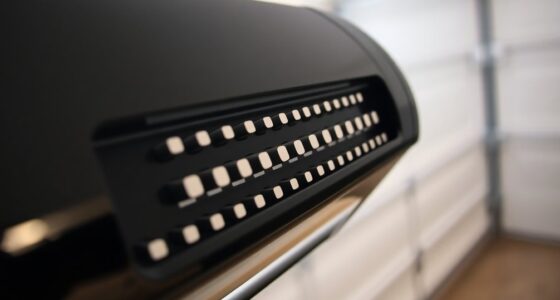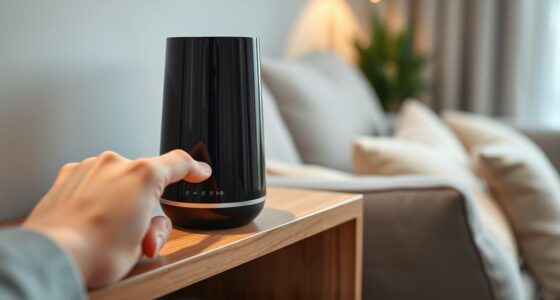Smart switches replace your traditional light switches, providing manual control and easy integration with smart home systems. They often require complex installation and a neutral wire. In contrast, smart relays are installed in junction boxes, simplifying the setup without visible switches, allowing you to control multiple circuits and traditional devices. While switches offer dimming and tactile feedback, relays function electronically without physical controls. Both have unique compatibility features, but your choice depends on your specific needs and preferences. Want to explore more about their functionalities and which one's right for you? Keep on discovering!
Key Takeaways
- Smart switches replace traditional switches and allow for manual and remote control, while smart relays operate solely through electronic control without physical switches.
- Installation of smart switches is more complex, often requiring a neutral wire, whereas smart relays simplify setup by not needing a neutral connection.
- Smart switches are designed for specific voltage ratings primarily for lighting, while smart relays can manage a wide range of devices and circuits.
- Aesthetic preferences vary; smart switches resemble conventional models, while smart relays allow for a cleaner, less cluttered installation without visible controls.
- Smart switches integrate with smart bulbs and home systems, while smart relays enhance automation for both smart and non-smart devices, often reducing internet reliance.
Design and Installation Differences
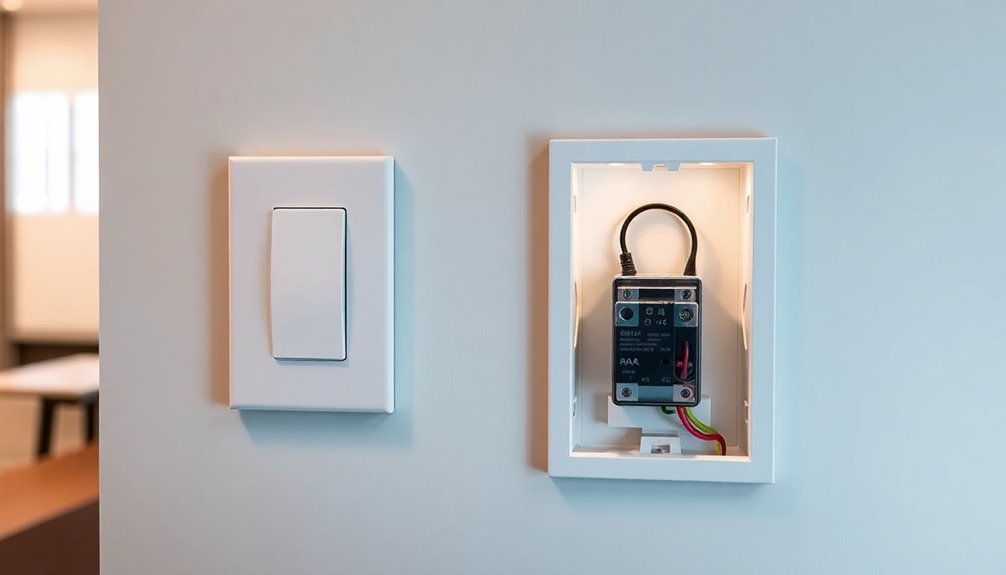
When you're considering the design and installation differences between smart switches and smart relays, it's essential to understand how they each function within your home.
Smart switches replace traditional light switches and require a more complex installation, including potential connections to a neutral wire. They often support dimming and integrate well with specific lighting systems. Additionally, smart switches provide tactile feedback, making them feel similar to traditional switches.
On the other hand, smart relays are installed in junction boxes, controlling multiple circuits without changing physical switches. Their installation is generally simpler and allows for automation of non-smart devices.
Both options enhance your home's functionality, but your choice will depend on your existing setup and desired capabilities.
Control and User Interface
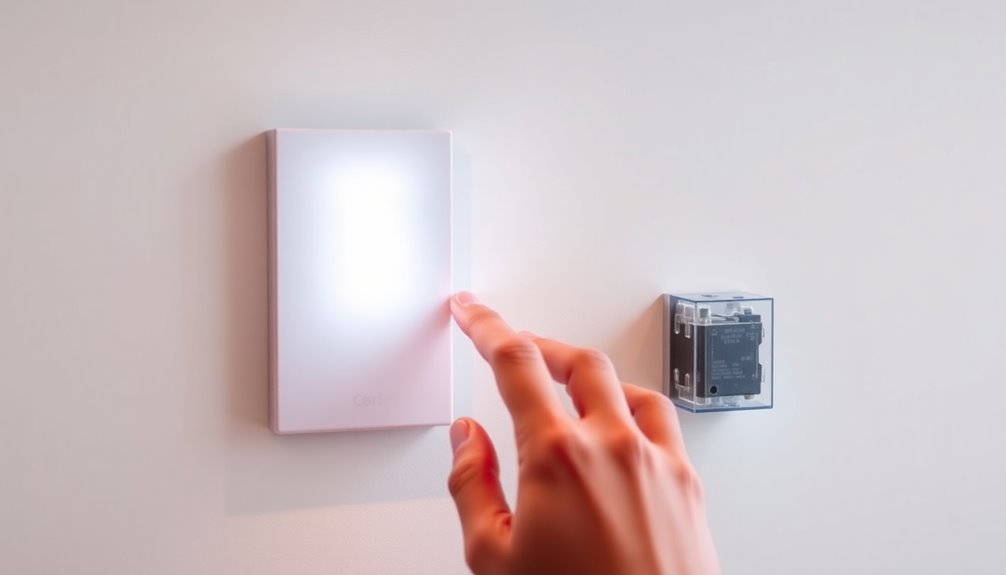
How do smart switches and smart relays compare with respect to control and user interface?
Smart switches offer a physical switch on the wall, letting you control your lights manually, just like traditional switches. You can also control them remotely through mobile apps, voice commands, or automation routines. Plus, many smart switches support dimming, allowing you to adjust brightness easily. Additionally, smart switches are designed to be user-friendly, providing a seamless experience much like the Samsung Smart Switch for transferring data between devices.
On the other hand, smart relays are entirely electronic. They don't have a physical switch and are installed in junction boxes. You control them remotely via apps or voice commands, and they can manage multiple circuits from one module. Some models offer dimming too, though it's not universal. Overall, your choice depends on your preference for physical control versus remote functionality.
Compatibility and Versatility
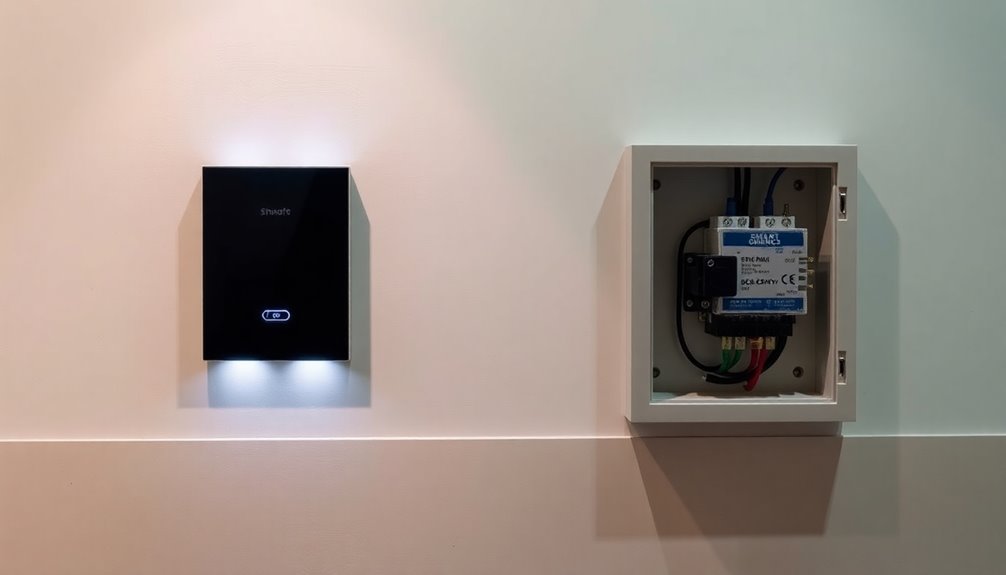
Compatibility and versatility are key factors to evaluate when choosing between smart switches and smart relays.
Smart switches are designed for specific voltage ratings and primarily control lighting fixtures or ceiling fans. They easily integrate with smart home systems for features like scheduling and energy monitoring. Additionally, smart switches must match local voltage standards, ensuring safe operation across different regions.
On the other hand, smart relays can manage a wide range of devices, regardless of their smart capabilities, making them highly versatile. They can control non-smart appliances and adapt to various voltages, enhancing your home automation options. This adaptability is essential for devices rated for specific voltages, as many smart relays are capable of operating under different voltage standards.
Additionally, smart relays can bridge traditional devices with smart systems, allowing for remote control and voice assistant integration. This flexibility makes them ideal for complex setups and converting existing switches into smart ones.
Wiring and Installation Complexity
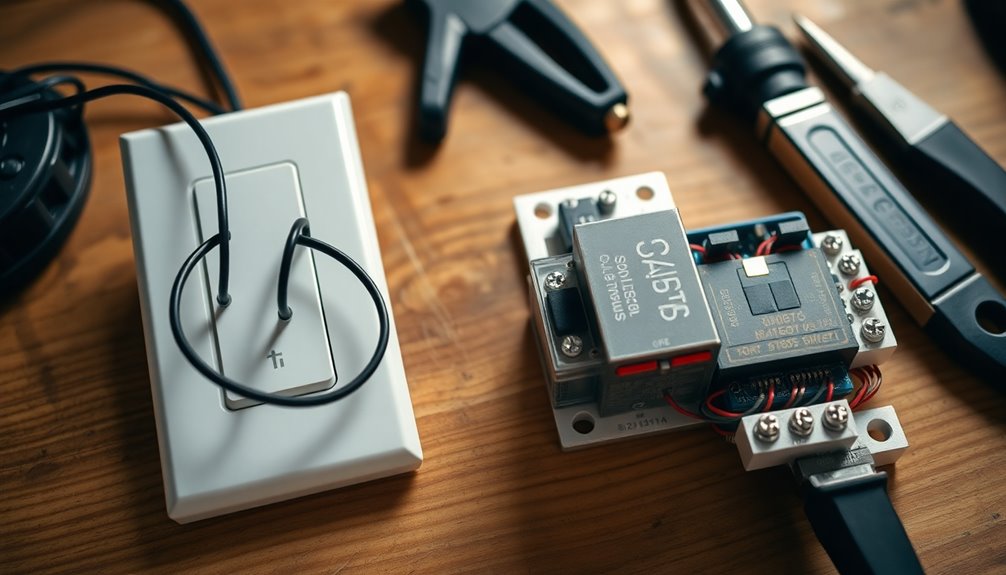
Choosing between smart switches and smart relays also involves considering wiring and installation complexity. Smart switches often require a neutral wire, which can complicate your installation process. You'll need to verify all wire connections are secure and may need to use connectors to avoid errors. Additionally, the presence of a physical switch adds another layer to the installation. On the other hand, smart relays don't require a neutral wire, simplifying the setup. You can connect them to existing wiring without replacing any physical switches, allowing for a more straightforward installation. Since they're typically hidden in junction boxes, you'll enjoy less visual clutter. Overall, smart relays provide a more accessible installation experience compared to smart switches, especially because many smart switches require a neutral wire for proper functionality.
Integration With Smart Home Systems

As you explore the integration of smart switches and smart relays into your home setup, you'll find that both options offer unique advantages for connecting with smart home systems.
Smart switches seamlessly integrate with systems like Philips Hue and voice assistants such as Alexa, allowing you to control lighting with ease. However, they may require specific smart bulbs for full functionality.
On the other hand, smart relays are versatile, controlling both smart and non-smart devices through various protocols like Zigbee and Z-Wave. They excel in automating multiple traditional switches, making them ideal for controlling various electrical devices.
Both options provide remote control and support automation, enhancing your home's connectivity and convenience.
Practical Applications and Use Cases
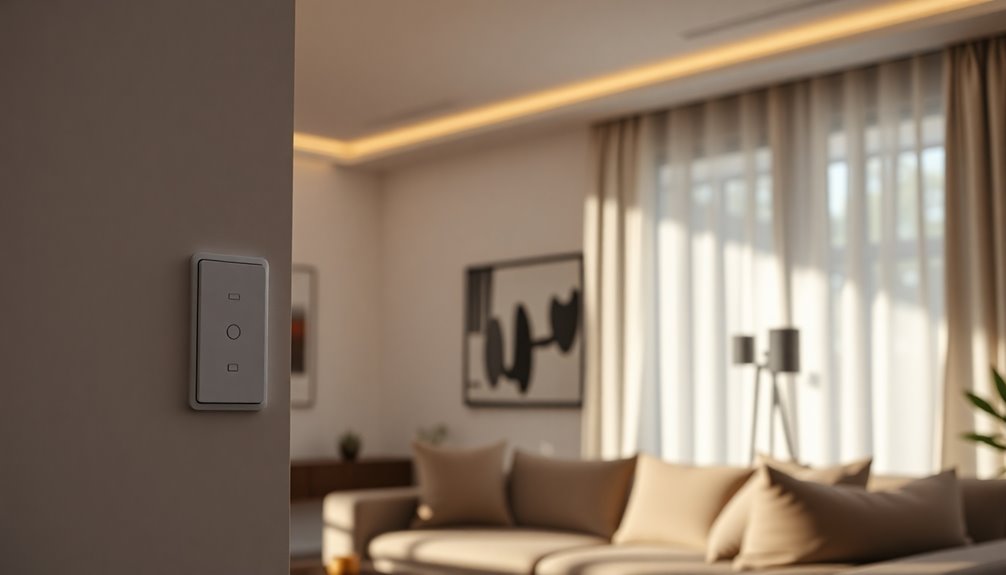
Both smart switches and smart relays offer practical applications that enhance your everyday life.
With smart switches, you can control your lighting and appliances remotely via your smartphone or voice commands. Imagine scheduling lights to turn on at sunset or creating a cozy movie scene with just a tap. They also allow for fan automation and appliance control, ensuring comfort and convenience. Additionally, smart switches are designed to integrate into home automation systems, making it easy to synchronize various devices for streamlined operation.
On the other hand, smart relays give you the versatility to control non-smart devices discreetly, maintaining your home's aesthetic. You can integrate them with traditional switches, allowing you to enjoy smart features without changing your existing setup.
Whether for security, convenience, or automation, both options elevate your home experience seamlessly.
Energy Efficiency and Monitoring
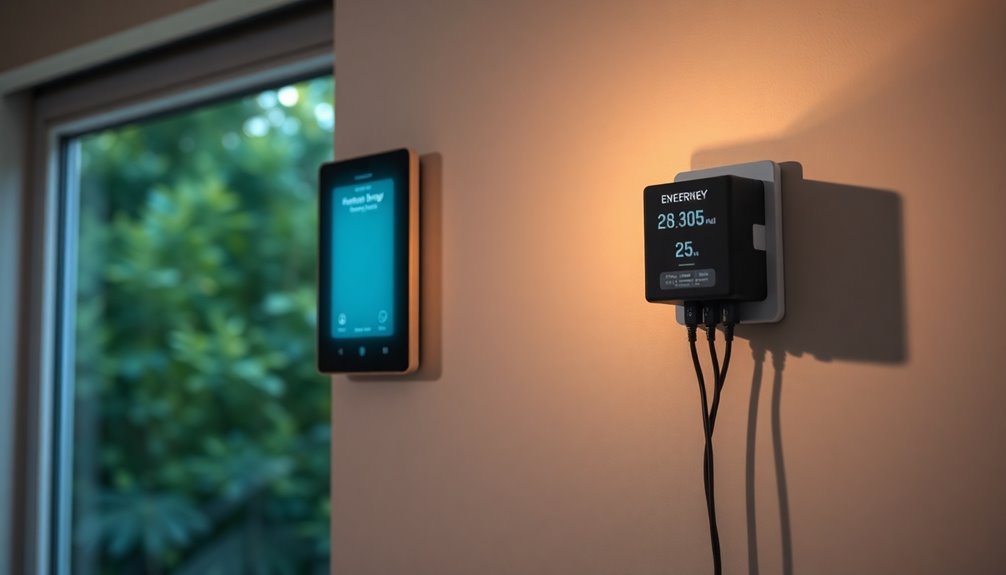
Energy efficiency is a key benefit of smart switches and smart relays, making them valuable additions to any home.
Smart switches excel in energy monitoring, providing real-time data on your power usage, helping you spot opportunities to save. With automation features, you can schedule devices to turn off when not in use, further optimizing energy consumption. Many also offer dimming capabilities, allowing you to reduce brightness and save energy when full intensity isn't needed. Additionally, smart switches can lead to long-term savings through energy efficiency, making them a worthwhile investment for homeowners. This aligns with the fact that energy-efficient systems can lead to a decrease in overall energy demand.
While smart relays monitor energy too, they focus more on automating non-smart devices. Both options allow remote control, ensuring you can manage your energy use even when you're away, promoting a more efficient and eco-friendly lifestyle.
Choosing the Right Option
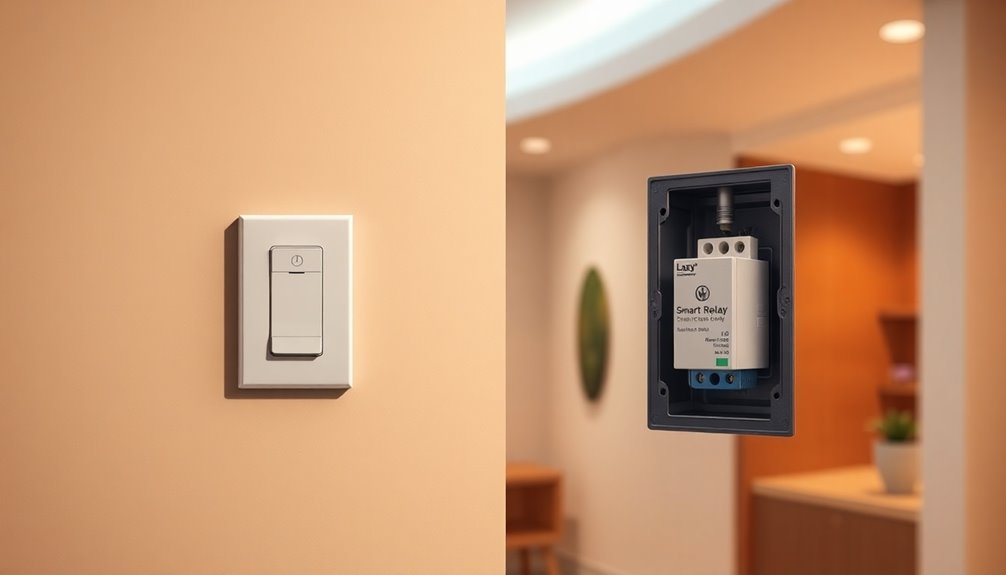
When deciding between smart switches and smart relays, what factors matter most to you? If you prefer physical control, smart switches might be your best bet, as they resemble traditional switches and allow manual operation.
However, if you want a cleaner installation without visible switches, consider smart relays, which hide away in junction boxes. Additionally, many smart relays, like the Shelly relays, offer local control capabilities, enhancing functionality without relying on cloud services.
Think about installation complexity, too. Smart switches often require more wiring work, while smart relays usually connect easily to existing setups.
If dimming features are important, check that the specific model supports it, as not all relays do.
Ultimately, your choice depends on your control preferences, aesthetic desires, and willingness to manage installation complexity.
Frequently Asked Questions
Can Smart Switches Work Without a Neutral Wire?
Yes, smart switches can work without a neutral wire, but their functionality is limited.
These switches maintain a closed circuit to control lighting, which means they can't completely cut off power. You'll find they often lack dimming capabilities and may require additional components for proper installation.
While you can control them remotely via apps or voice commands, you won't have manual toggle control.
Are Smart Relays Compatible With Dimmable Lights?
Yes, smart relays can be compatible with dimmable lights, but it depends on the specific model you choose.
Some smart relays support dimming functions for LED, incandescent, and halogen lights, allowing you to adjust brightness levels.
When selecting a relay, make certain it meets the wattage requirements and check for compatibility with your existing dimmable lights.
Always verify installation needs to confirm everything works smoothly in your setup.
How Do Smart Switches Enhance Home Aesthetics?
Smart switches enhance your home's aesthetics by offering sleek, modern designs that blend seamlessly with any decor.
Their customizable LED indicators and slim profiles create a polished look, while eliminating clutter with consolidated functions.
You'll enjoy a minimalist appeal that optimizes space and promotes clean lines.
Plus, they integrate effortlessly with your smart home system, allowing for synchronized controls that elevate your living environment, making it both stylish and functional.
Can I Control Smart Relays From Outside My Home?
Yes, you can control smart relays from outside your home!
Most smart relays come with mobile app support, letting you manage them remotely from your smartphone or tablet.
You can also access them through a web browser, making it easy to monitor and adjust settings.
Plus, if your smart relay integrates with voice assistants, you can use voice commands to control it, ensuring convenience no matter where you are.
Do Smart Switches Require an App for Basic Functionality?
No, smart switches don't require an app for basic functionality.
You can easily turn the lights on or off using the physical switch on the wall, just like a traditional switch. This manual operation allows immediate control without needing to open an app.
However, if you want to access advanced features like remote control or automation, you'll need to use the associated app for those functionalities.
Conclusion
To summarize, choosing between a smart switch and a smart relay boils down to your specific needs and setup. If you want a straightforward user interface and easy control, a smart switch might be your best bet. However, if you're looking for versatility and integration with existing systems, a smart relay could be the way to go. Consider installation complexity and practical applications in your home to make the best choice for your smart home project!




